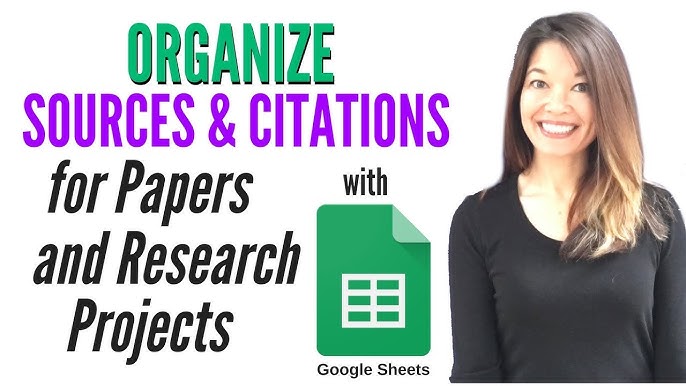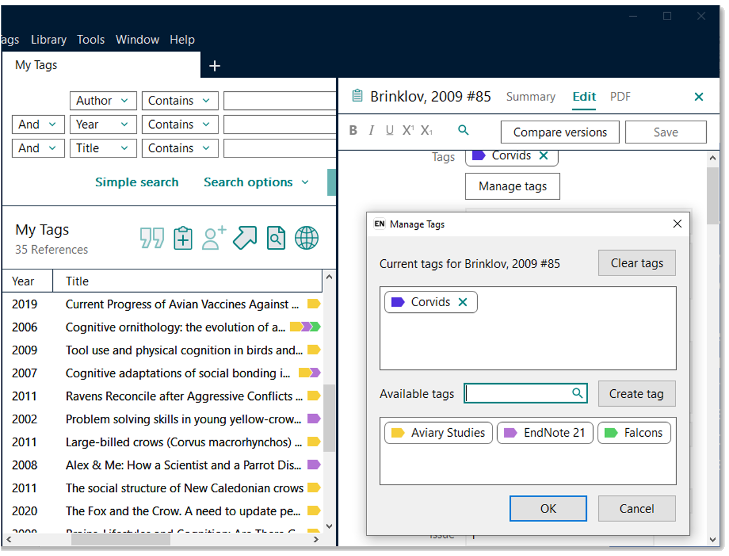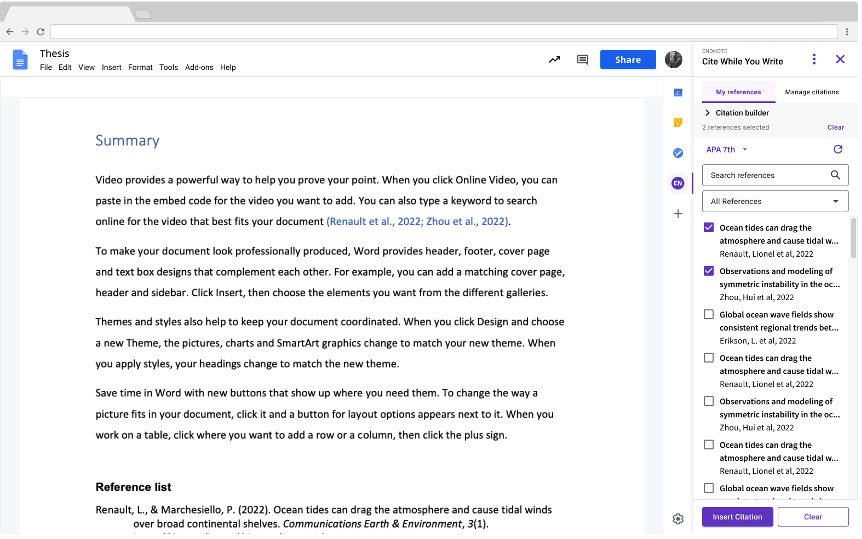How to Organize Research And Citations in Google Docs: A Step-by-Step Guide
Organizing research and citations can be challenging. Google Docs offers tools to simplify this process.
Research and citations are crucial for any project. They add credibility and structure to your work. Google Docs provides user-friendly features that help manage these elements efficiently. From in-built research tools to citation add-ons, it streamlines the process. Knowing how to use these tools can save you time and reduce stress.
This guide will show you step-by-step methods to organize your research and citations. Whether you are a student or a professional, mastering these skills will enhance your productivity and the quality of your documents. Let’s dive in and explore how Google Docs can make your research tasks easier.

Credit: www.youtube.com
Introduction To Google Docs For Research
Google Docs is a great tool for research. It is free and easy to use. You can access your documents from any device. This means you can work on your research anywhere. Collaboration is simple. Share your document with others. They can edit and comment in real-time. This helps when working in groups.
Changes save automatically. You never lose your work. Google Docs also has powerful search functions. Find any part of your document quickly. Add links, images, and tables with ease. These features make organizing your research simple and efficient.
| Feature | Benefit |
|---|---|
| Real-time Collaboration | Work with others easily |
| Automatic Saving | Never lose your work |
| Access Anywhere | Work from any device |
| Search Functions | Find information quickly |
| Easy Formatting | Add links, images, and tables |
Setting Up Your Research Document
Open Google Docs. Click on the blank document option to start fresh. This will give you a clean slate.
Google Docs offers various research templates. These templates help in structuring your document. To find them, go to the template gallery. Choose a template that fits your needs. This helps in saving time and organizing your work better.
Structuring Your Research
Organize your research and citations in Google Docs for easy reference. Use headings, subheadings, and bullet points to keep everything clear. Add citations with the built-in citation tool for proper documentation.
Organizing Sections
Creating a clear structure is key. Use different sections for different topics. This helps keep things neat. Start with a main heading for each major topic. Under each main heading, add subheadings for smaller topics. This way, you can find information fast.
For example, if researching animals, have sections like mammals, birds, and reptiles. Under mammals, you can have subheadings like lions, bears, and whales. This makes your document easy to read and understand.
Using Headings And Subheadings
Headings and subheadings make your document more readable. They break up text into smaller parts. This helps in finding information quickly. Use bold text for main headings. Use italic text for subheadings. This way, important sections stand out.
Google Docs has built-in styles for headings. Use these to keep your document consistent. For example, use “Heading 1” for main headings. Use “Heading 2” for subheadings. This will keep your research organized and clean.
Inserting Citations
The Explore Tool in Google Docs is very helpful. It helps find information and add citations quickly. Click the small star icon at the bottom right. Enter your topic in the search bar. Results will appear on the right side. Hover over a result to see a quote mark icon. Click it to add the citation. The citation will be added to your document. This method saves time and keeps your sources organized.
Sometimes, you need to add citations manually. Place your cursor where the citation should go. Click “Tools” in the top menu. Then click “Citations.” A sidebar will appear on the right. Select the citation style you need. Click “Add citation source.” Fill in the required fields. Click “Add citation source” again. The citation will be added to your document. This method is useful for custom citations.
Managing Sources
Google Docs has a built-in tool for creating bibliographies. This feature helps you organize and format your sources. First, select the “Tools” menu. Then, click on “Citations.” Choose the citation format you need. Enter your source information. Google Docs will automatically format it for you. This saves time and ensures accuracy.
Keep your source information in a separate document. This document should include all your citations. Also, add notes about each source. This helps you remember key points. Use Google Docs to store this information. It’s easy to access and edit. Organize your sources alphabetically. This makes finding them easier.
Collaborating With Others
Sharing your document is simple in Google Docs. Click the “Share” button at the top right. Enter the email addresses of the people you want to share with. You can choose if they can view, comment, or edit. It’s easy and quick.
Comments help you give feedback or ask questions. Highlight the text and click the comment icon. Type your thoughts and click “Comment.” Suggestions let you edit without changing the original text. Click “Editing” mode and switch to “Suggesting.” Type your changes and they will appear as suggestions.
Using Add-ons For Enhanced Research
Google Docs has many add-ons for research. EasyBib is one of them. It helps to create citations. Paperpile is another useful tool. It saves and organizes research papers. Mendeley is good too. It helps you find and read research papers. These tools save time. They make your work easier.
Managing citations is important. Zotero is a great add-on. It helps collect and organize sources. EndNote is another option. It simplifies citation management. RefWorks is also useful. It helps to manage and share research materials. These tools help keep your research neat.

Credit: endnote.com
Finalizing Your Research Document
Organize research and citations in Google Docs easily. Use built-in tools for seamless citation management. Keep your document structured and polished.
Proofreading And Editing
Proofreading is important. Look for spelling mistakes. Fix any grammar errors. Read your work out loud. This helps catch mistakes. Break long sentences into shorter ones. Make sure each sentence is clear. Editing improves your document. Remove extra words. Simplify complex sentences. Be sure to cite sources correctly. Use consistent formatting. Check your references list. Make sure all citations match. Proper formatting makes your document look professional.
Formatting And Styling
Formatting helps with readability. Use headings and subheadings. They organize your document. Bold important points. Use bullet points for lists. This makes information clear. Use consistent font size and style. Avoid using too many fonts. Keep margins and spacing uniform. This gives a clean look. Use a table of contents. It helps readers navigate your document. Proper styling makes your research easy to follow.
Best Practices For Research Organization
Choose one citation style for all your sources. This makes your document look tidy. Common styles are APA, MLA, and Chicago. Pick one and stick with it. Use Google Docs tools to help format your citations. This saves time and keeps everything neat. Make sure to check each citation for errors. Consistency is key to good research organization.
Save your work often. Use Google Drive to store your documents. This keeps them safe from computer problems. Turn on auto-save in Google Docs. This feature ensures you never lose your changes. Create copies of your documents. Save them to an external drive or cloud service. Regular backups prevent data loss. They help you keep track of your work.

Credit: endnote.com
Frequently Asked Questions
How Do I Organize Research In Google Docs?
Use headings and subheadings. Create a table of contents. Use bullet points. Keep notes organized.
Can Google Docs Help With Citations?
Yes, Google Docs has a citation tool. It supports MLA, APA, and Chicago styles. Easy to use.
What Is The Best Way To Add References In Google Docs?
Use the built-in citation tool. Insert citations directly. Manage references easily. Keeps your document tidy.
How Can I Share My Google Docs Research?
Click “Share” button. Add email addresses. Set permissions. Collaborate in real-time. Simple and efficient.
Conclusion
Organizing research and citations in Google Docs makes writing easier. It saves time. It keeps your work neat and professional. Use the built-in tools for citations. They help track your sources. This method enhances accuracy in your papers. Consistent organization leads to better results.
Stay focused and efficient. Google Docs is user-friendly. Start organizing your research today. It simplifies the process. Happy writing!







